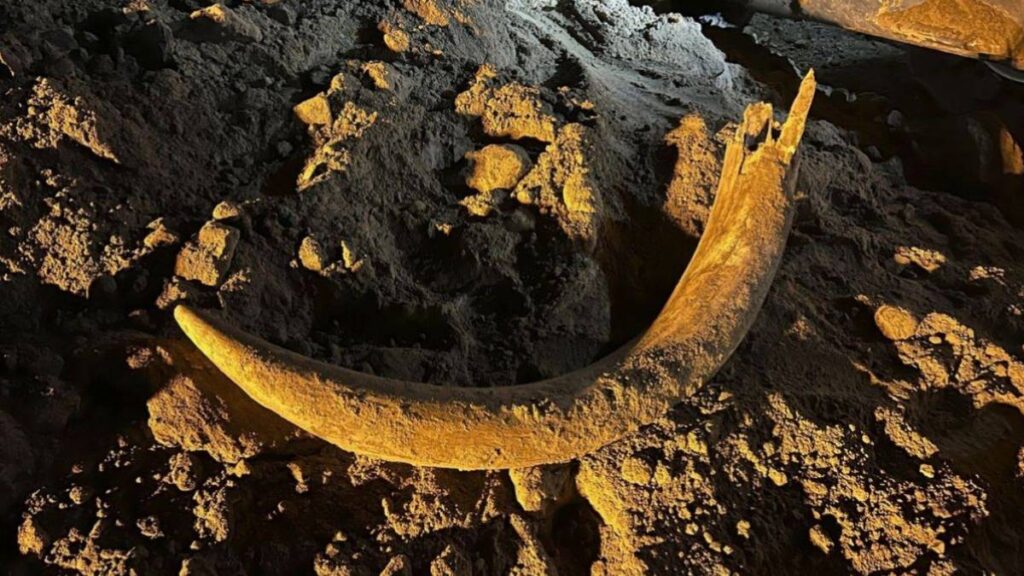Somewhere at the Freedom Mine close to Beulah, North Dakota, miners made an unbelievable discovery. It was a large tusk of the long-extinct Mammoth.
A shovel operator first came close to finding the prized object. As he lifted scoop after scoop of dirt into the dump truck, his eyes caught a glint of white.
It was an overnight shift, and the tusk shone brighter than it would have done in the daytime. But somehow, he managed to miss the 7-foot-long object. The dump truck driver had a slimmer chance of finding the tusk as he simply dumped the load.
Finally, it was the dozer driver who came to flatten the dirt that caught the curious white object. When they unearthed the tusk, they were shocked beyond words. David Straley, an executive of North America Coal and owner of the mine, told the press that his workers were lucky to find the object.
They were simply doing their job just like any other day at the mine. The mine covers 45,000 acres of land and produces up to 16 million tonnes of lignite coal annually. The tusk was lying on an old streambed, about 45 feet deep.
Also Read: Court Backs Tribes’ Effort to Redraw North Dakota Legislative Boundaries
The discovery prompted the miners to halt their digging. They called experts to examine the tusk. After analysis, the scientists found that the tusk was between 10,000 to 100,000 years old.
Jeff Person, an experienced North Dakota Geological Survey Paleontologist, had something interesting to say. He disclosed that it was a miracle for the tusk to survive the impacts of the large-scale mining activity in the area. He was surprised that the tusk remained in one piece.
When experts supervised more digging at the site, they found more bones. A person described the 20 additional bones as a “trickle of finds.” The newer bones included ribs, a tooth, parts of hips, and a shoulder blade.
POLL—Is Climate Change a Major Threat That Requires Immediate Policy Action?
Although all the bones they found were a long shot from the full structure, it was the state’s most complete collection of Mammoth bones. People have been used to finding isolated pieces of Mammoth bones in North Dakota, such as small pieces of tusks and bones.
“It’s not a lot of bones compared to how many are in a skeleton, but it’s enough to know that this is all associated,” Person said.
Mammoths are one of the most iconic long-extinct animals. They share lots of popularity with the dinosaurs. Mammoths inhabited parts of Africa, Asia, Europe, and North America. Many of their remains have surfaced over the years in parts of the United States and Canada.
Also Read: Scientists Believe Saccorhytus, A Strange-Looking Extinct Creature is Humans’s Earliest Ancestor
Mammoths were considerably larger than elephants and had thick woolen coverings to shield them from the cold of the Ice Age. They lived during the last Ice Age but lost all their population to glaciation and the movement of ice sheets.
This tusk weighs more than 22.6 kg and has been wrapped in plastic due to its fragility. Paleontologists say plastic wraps will reduce the rate at which it loses water. If it loses water too quickly, the bone will split into pieces.
The miners want to donate their discovery to the government. They want school kids to benefit from every education the object can provide. Before then, the tusk will remain in the safe hands of scientists for its preservation.
You Might Also Like This:
Florida Abortion Rights Measure Gets Enough Signatures to Appear on Ballot
Conservatives Harrass Small Town Library Into Shutting Down Over Drag Queen Story Hour
Michigan Woman Wins $2 Million After Store Clerk Picked Out Scratch Off for Her
Officials Identify Headless, Blood-Drained Cold Case Victim After Nearly Thirteen Years
60-Year-Old Teacher Undergoes Brain Surgery After Student’s Attack
